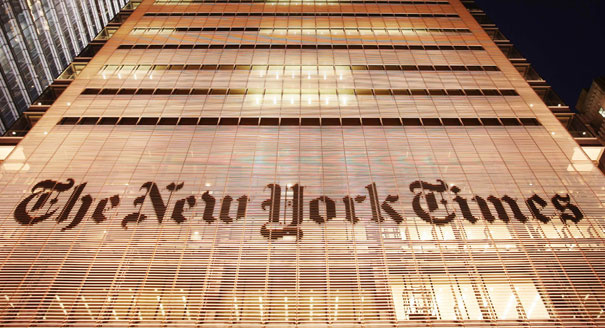New York Times and Disinformation on Iran
Kaveh L. Afrasiabi

Over the years, the New York Times has accommodated itself to the incessant propaganda against Iran by occasionally recycling the calibrated disinformation on Iran's peaceful nuclear program, even to the point of sheer factual errors that, normally, ought to be quite embarrassing to its publishers.
Case in point, in a recent news article written by the veteran reporter David Sanger, dated August 21, 2015, the old accusations about evidence of nuclear weapons work at Parchin military complex are adopted at face value and the author states: "The suspicions about what once happened at Parchin are so old that International Atomic Energy Agency inspectors asked to enter the base in 2004 and actually got inside — once — in November 2005."
This is factually wrong. The IAEA visited Parchin twice in 2005, in January and November, inspecting several buildings each time, without finding anything suspicious, despite all the hoopla about "commercial satellite images" that purportedly showed "suspicious activities" at those buildings, per reports published by the Institute for Science and International Security (ISIS), which were faithfully parroted by ABC and other American media outlets back then. Sanger's error is confirmed by Olli Heinonen, the then Deputy Director-Genral at IAEA, who headed the inspection team visiting Parchin on both occasions in 2005, in a letter to this author, dated August 23, 2015. Mr. Heinonen states:
"The IAEA visited the site twice in 2005. Both times the purpose was to look at the test stands and bunkers and adjacent laboratories for certain type of high explosive work. In addition to the identification of the structures and equipment in those locations, environmental samples were taken. The access was unrestricted, but in certain cases some military objects were shrouded. However, this was OK for us, and we were able to complete the works as planned and with information available at that time."
Sanger not only makes the egregious error of omitting any reference to the January 13th IAEA visit, he also goes on to say, "They found nothing. But soon after, they concluded they were probably in the wrong buildings." In fact, that was the basis, or rather justification, for the second request that was granted in November, 2005, when the IAEA based on its "reliable information" selected five buildings for inspections and environmental samplings -- that turned out quite embarrassing to IAEA by virtue of finding absolutely nothing suspicious. The IAEA chose the buildings on both occasions and there was no restrictions on any part of Parchin. Surely, if Iran had anything to hide would not have consented to such inspections.
Lest we forget, at that time, both the respected scientists of ISIS led by David Albright and the US envoy to UN, John Bolton, made a huge public fuss about Parchin and none of them were willing to admit a mistake after the IAEA issued its reports, e.g., in February, 2006, confirming the falsehood of those baseless allegations.
Sanger's other error is that he claims after 2005 Iran has "turned down" subsequent IAEA requests for further Parchin visits. This omits the delicate yet important point that Iran has always insisted that Parchin is not a nuclear facility and therefore any more visits must transpire within the framework of a new modality for cooperation -- which Iran has now signed with the IAEA, thus raising the prospect that by mid-December the whole "possible military dimension" (non) issue will be resolved once and for all.
` Unfortunately, this is not the only example of New York Times disinformation on Iran and another example is David Sanger's high-profile 2005 report about a stolen computer laptop that purportedly contained a sea of information on Iran's clandestine nuclear activities, including designs for nuclear warheads. The American author Gareth Porter has done an excellent job in exposing the "laptop of mass destruction" disinformation stemming from planted fake evidence, in his book, Manufactured Crisis (2014). Old habits die hard and clearly the new focus on Parchin is made of the same tissue of propaganda aimed at smearing Iran and undermining the recent nuclear agreement. As stated in my own book, Iran's Nuclear Program, Debating Facts versus Fiction (2006), the factual errors of Mr. Sanger (and his colleague William Broad) in that report were so egregious that even the ISIS scientists had to publicly distance themselves from it.
In his latest piece on Iran, Sanger refers to "all the evidence" on Parchin corroborating the nuclear weapon allegations, thus papering over the significant doubts about the authenticity of those evidence, e.g., Sanger in his own November 13, 2005 article cited a "senior European diplomat" who cast serious doubt about the new evidence and was quoted: "I can fabricate that data. It looks beautiful, but is open to doubt." Similarly, the former Director-General of IAEA, Mr. Mohammad ElBaradei, repeatedly confirmed that the agency was not in possession of "any credible evidence" of nuclear weapons-related work in Iran.
It is therefore supremely duplicitous on Mr. Sanger's part to claim that "all the evidence" suggests that "Parchin probably was a significant site for nuclear weapons research and experimentation a decade ago." In fact, there is no credible evidence that corroborates this wild claim about Iran -- that stems party from obligque references to Vlachyslav Danilenko, a Ukrainian scientist who once taught theoretical physics in Iran and later firmly denied that he had ever done any work related to nuclear weapons. Former IAEA inspector Robert Kelley has repeatedly debunked the allegations about hydrodnamic testing at Parchin, yet he is never quoted by Mr. Sanger and other like-minded U.S. journalists determined to somehow find a "smoking gun" by relying on discredited information. But, in light of the egregious factual errors mentioned above, Mr. Sanger and the New York Times only end up discrediting themselves in the international community.

